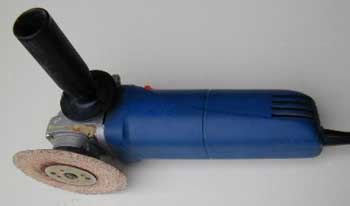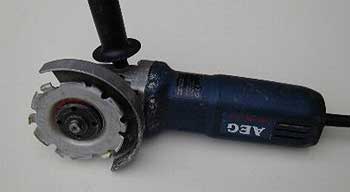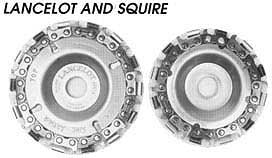|
Pictured
below is an average angle grinder. They come in a range of power outputs and a
huge range of prices depending on the make and model. This is the most common
secondary tool chosen by chainsaw carvers. Complete with a sanding disc it is
indispensable when it comes to removing saw marks and giving a chainsaw carving
a smooth finish. Note the guard has been removed, but only for sanding applications.
Gloves should be worn, as well as a dust mask, eye protection and ear protection
(they do make quite a lot of noise).
Fitted with a coarse sanding disc
it is possible to finely sculpt the wood as well as removing all saw marks. Fine
discs give a very fast, even smoother, finish. The discs have to be of the fabric
reinforced variety, designed specifically for angle grinders. Do not use discs
larger than that designed for the angle grinder. They will almost certainly fly
apart. A flexible plastic backing pad made for sanding discs has to be used.
|
 |
The drawback with the angle grinder is that it's not very good at getting in to
tight spaces. The side handle can be removed, which helps a bit. However, it is
excellent for cleaning up and fine tuning large, in particular convex, surfaces.
|
Wood Cutting Discs |
Or to
be more precise, wood cutting discs for angle grinders, not circular saws. This
is a disc of the "Arbortech"
variety. They are pressed steel discs with chainsaw style teeth formed on the
rim. The mounting nuts that come with the angle grinder for grinding discs, are
used with these cutting discs. |
 |
Note that it is essential that the guard be fitted to
the grinder.
The guard in the picture has been fitted to use
the disc as a cutting/trenching tool. It can be moved round fully towards the
cable end in order to use the tool for skimming surfaces (rather like the action
of a grinding disc).
|
It should be said that these discs are very dangerous. They can snatch and
kick unexpectedly causing them to be wrenched from the operators hands. If the
switch is not of the paddle type, the machine can land still spinning and proceed
to jump about, cutting everything it comes in contact with until the power is
switched off. This usually includes the operator. As an extra precaution, anyone
using this machine would be advised to wear chainsaw type protective gloves, over
and above the eye, and possibly ear protection that is standard. The chips are
too big to bother with a dust mask generally.
I personally believe that
these attachments are more dangerous than chainsaws. They can, in careful hands,
remove a lot of wood quite quickly. They may be the only option for those who
have no access to chainsaws, or for indoor
work. A chainsaw will however, cut far deeper
and more effectively than one of these blades. Chainsaws will also perform all
of the functions of these blades, and more.
|
Here we have a tungsten carbide tipped cutting disc
for the angle grinder. Doesn't snatch as much as the previous disc. Leaves a rougher
surface in softwoods but works quite well in hard woods. It's even claimed that
it can be used with aluminium. Once again it's from "Arbortech"
The teeth can be loosened and rotated to present new cutting edges.
Or be removed and replaced.
Same safety precautions as above. | |

|
Another variation on the theme. These are chainsaw chain loops mounted between
two large washers. The idea is that the cutters will slip in their mounting washers
if they hit anything that they might snatch on. They do seem to cut quite smoothly.
There is the facility to use two different sized discs in tandem on the angle
grinder at the same time. Special mounting nuts are supplied with the blades. |
For
more information on Lancelot and Squire go to: www.katools.com
|
|
|


